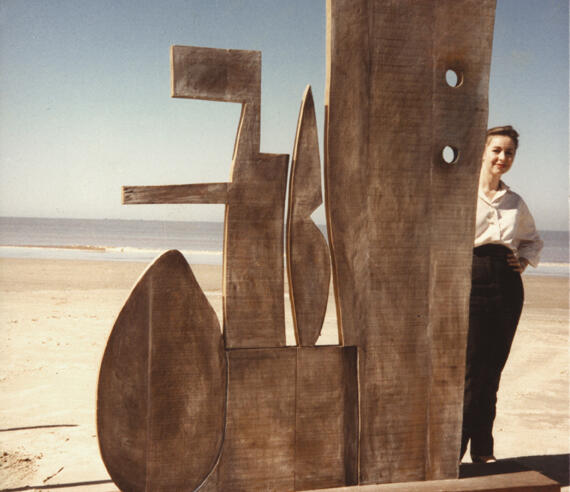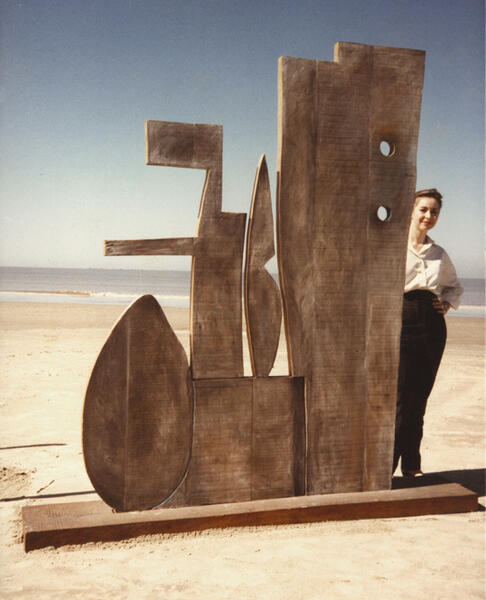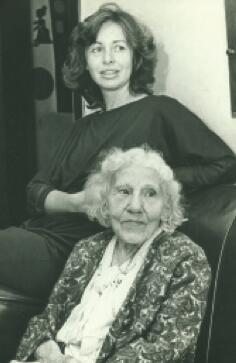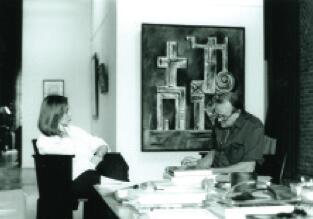Cecilia de Torres
a passionate art lover turned detective
In the course of her life, Cecilia de Torres has been in close contact with some important figures of Latin American modern and contemporary art. But this is not the story of the gallerist who has built bridges for Latin American art to become known in the United States and Europe. This is a journey through the most intimate memories of a person who was the muse of Horacio Torres, one of the greatest figurative artists of the 20th century. She was a close friend of artists José Gurvich, Gonzalo Fonseca, Francisco Matto, and César Paternosto; the promoter of emerging talents such as Marta Chilindrón and Elías Crespín; and, above all, the tireless guardian of the legacy of the pioneer of abstract art in Latin America, Joaquín Torres-García

How Cecilia de Torres ultimately became the voice of Latin American art in the United States is a fascinating story, even for those who are already familiar with her trajectory as a curator, an essayist and an art dealer.
Born in Argentina but raised in Uruguay, she had the privilege of pursuing her painting studies at the Torres-García Workshop, an institution that aroused controversies in the conservative mid- twentieth century Montevideo because of its avant-garde proposals regarding the visual arts. There, Cecilia de Torres was a pupil of José Gurvich at the age of sixteen. Since that time, they cultivated a strong friendship that was to last until the painter’s untimely death in 1974.
Of those days at the Workshop and following her marriage to Horacio Torres, Joaquín Torres-García’s youngest son, she has treasured memories of endless gatherings with masters Francisco Matto, Julio Alpuy and Gonzalo Fonseca, with art critic Clement Greenberg and the then curator of the Museum of Fine Arts Boston, Kenworth Moffett, and with other artists and thinkers of the time, who formed part of her circle of friends. Today, her gallery in the New York So Hoservesasa platform for established artists such as César Paternosto, León Ferrari and Eduardo Costa, or for emerging artists like Marta Chilindrón, Inés Bancalari and Elías Crespín; but it is also the place where she carries out the endless task of compiling the catalogue raisonné of the works of the pioneer of abstract art in Latin America, Joaquín Torres-García. Cecilia de Torres is an open book when it comes to learning how Latin American art has gradually carved a place for itself in the impenetrable cultural milieus of the United States and Europe.
CL: Did you know master Joaquín Torres-García?
CdeT: When I was a little girl, our house was two houses away from his in Punta Gorda (Montevideo) and I always saw him from a distance. His white beard rendered him very conspicuous, because at that time few men wore a beard in Montevideo.
CL: What do you remember about your early days as a student at the Workshop?
CdeT: The informality. When I arrived there to enroll, José Gurvich asked me my name and he wrote it down on the corner of one of the pages of the newspaper he was reading. Everything I learned was not of an academic nature. You were taught to see everything from the point of view of the visual arts, to see reality in the artwork itself, instead of copying reality. But when it came to painting, discipline, hard work and rigor reigned. Once a week there were meetings in which we discussed the works that each of us presented. There were no egos at stake, as is the case in art today. To submit your work to the opinion of the workshop community was an exercise of letting go of subjectivity.
CL: What was the atmosphere like at the workshop?
CdeT: When I entered the painting shop, Augusto Torres, Julio Alpuy and Gonzalo Fonseca had already left, but those who remained in Montevideo had gained artistic maturity. There was a very strong interest in architecture and its relationship with mural painting; also in applying Constructivism in all aspects of life.
CL: Who were you closest with?
CdeT: Francisco Matto was a great friend. He had a great interest in music. I remember he could whistle entire fragments of a quartet by Beethoven, and he was passionate about Bach. Manuel Pailós worked as a milkman for Conaprole. I always ran into him on my way to high school. That was another extraordinary aspect of the workshop: it gathered together people from every sphere of society who shared a common interest in painting.
With Torres-García in New York
CL: How did you become involved with the Workshop beyond your role as a student?
CdeT: Soon after finishing high school, I married Horacio Torres and we had three children. When the first Joaquín Torres-García retrospective exhibition, which was inaugurated in December 1970 at the Guggenheim Museum in New York, was being organized, I was the only one in the family who spoke English. So I went from changing diapers to translating letters, acting as an interpreter and being in contact with the museum.
CL: Have you any anecdotes about the organization of that exhibition?
CdeT: My husband, my children and I traveled to New York on a cargo ship, because that trip was Horacio’s dream. It was a Norwegian freighter, and we were the only passengers. It was a wonderful trip that lasted a month and allowed us to know all the coast of Brazil. The exhibition was disastrous. In the The New York Times, art critic John Cannaday wrote terrible things in two articles published only days apart.
CL : When did you move to New York?
CdeT: After that exhibition and in view of the political situation in Uruguay, we decided to leave Montevideo. Thanks to art critic Clement Greenberg, we came to New York and Horacio began to achieve incredible success. We had a relationship with galleries such as Tibor de Nagy and Noah Goldowsky, which were important at that time. Additionally, we were connected with New York’s emerging art world.
CL: How do you remember your husband?
CdeT: He had decided to devote himself to figurative painting, after having done a great deal of experimentation with abstraction. I was not detached from that. One might almost say that it was a joint endeavor. I helped him in every sense: from posing for him to representing him before galleries and museums.
CL: Who formed part of your circle of friends?
CdeT: We had a close friendship with painter Jules Olitsky, sculptor Michael Steiner, art critic Clement Greenberg, and curator Kenworth M. Moffett, who organized Horacio’s first exhibition at the Museum of Fine Arts Boston (1974).
CL : Whom did you consider your closest friends among the Latin Americans?
CdeT: Marcelo Bonevardi, Gonzalo Fonseca, José Gurvich, Francisco Matto and Julio Alpuy. The bond among all of us was much stronger than family ties. We were a very united group.
CL: How did you become involved in the promotion of Latin American art?
CdeT: Part of the motivation that led me to devote myself to the promotion of Latin American art was my friendship with those artists who were not well represented in galleries in the United States. After Horacio’s death in 1976, I gradually became aware of the fact that Latin American art is widely unknown in the United States. That is why I decided to focus on something that I knew intimately: the Torres-García Workshop. But I also took Arnold Herstand to Gonzalo Fonseca’s studio, which eventually made it possible for him to organize multiple exhibitions. Much later, the first exhibition I staged when I opened my own gallery with the support of Bernard Chappard and Dan Pollock as director in 1993, was dedicated to Francisco Matto.
Gurvich and Fonseca, among friends
CL: What do you remember about José Gurvich, the artist?
CdeT: He had small but penetrating eyes, and they were always observing. All that world he observed he later translated onto his work with incredible poetry and beauty. He was extremely well-disciplined with regard to work, but this did not prevent him from having fun. He was a very optimistic, vital being. His death was very painful.
CL: What memory of your friend comes to your mind?
CdeT: Whenever my husband showed him his paintings, Gurvich simulated holding a brush in his hands and pretended he was filling the empty spaces my husband left in his backgrounds, for in his, as you may know, there isn’t a centimeter that is not painted.
CL: Gonzalo Fonseca was also someone who was always present in your home.
CdeT: We gathered together for dinner once a week. He spent the whole fall and winter in New York, and summer in Italy. The art of antiquity was his passion. He was fascinated by the past. He loved the etymology of words, and he always mentioned the origin of each term.
CL: What shared experiences do you consider unforgettable?
CdeT: It was very nice to visit exhibitions together here in New York. For all of them, being in New York was a festival. Coming from Montevideo, where there was so little art to see, to be able to attend multiple exhibitions and visit art supply stores was a feast.
Detective work
CL: What was the implementation of the exhibition “School of the South: El Taller Torres-García and its Legacy” at the Blanton Museum of Art, (1991) like?
CdeT: With Mari Carmen Ramírez we had an incredible rapport and the exhibition was a success. In The New York Times, Holland Cotter drew a parallel between what happened in New York and in Montevideo at the same time.
CL: When did you begin to write?
CdeT: Writing is my passion and my pain. When Mari Carmen Ramírez, then curator of Latin American Art at the Archer M. HuntingtonArtGalleryattheUniversityofTexas,Austin,approved the exhibition “El Taller Torres-Garcia. The School of the South and its Legacy”, she entrusted me with the chapter on the Workshop, and I had no option but to start writing. Since then, I have written texts for several publications, such as the catalogues for “Constructive Spirit: Abstract Art in North and South America” (Newark Museum, 2010), “Geometry of Hope” (Grey Gallery, 2007), Nexus New York (El Museo del Barrio, 2009) and the catalogue raisonné for the Blanton Museum of Art. My most recent project was the one for the exhibition “Toys of the Avant- Garde” (2010), featured at the Picasso Museum in Málaga. My first work dates back to 1970, when in Montevideo we prepared, together with my sister-in-law Ifigenia Torres, the chronology, bibliography and list of exhibitions for the Guggenheim catalogue.
CL: What has been the most surprising finding for Joaquín Torres- García’s catalogue raisonné?
CdeT: When Mari Carmen Ramírez was curating the exhibition “Joaquín Torres-García. Constructing Abstraction with Wood” (2009) for the Menil Collection in Houston, we found in France three paintings and a wooden sculpture dated 1928 of whose existence we knew nothing.
CL: Did you imagine how difficult it would be?
CdeT: It is detective work. There must be an order, and the exhibitions and publications in which each work has been included must be listed. It often happens that although the works may be listed, dates and dimensions are unavailable.
CL: After so much work, do you still continue to find treasures?
CdeT: The other day, a French gallery sent me the photograph of a 1939 painting, from the days when Torres-García still lived in Montevideo. Its provenance was the family of Torres-García’s dentist’s wife in Uruguay. We have obtained works mainly in Uruguay, Italy, France, Spain, Argentina, Venezuela and even in Stockholm, Sweden.
CL: Why are you so concerned about developing this catalogue raisonné?
CdeT: There can be no true knowledge of an artist until his or her work is organized into a chronological structure that makes it possible to understand his or her evolution. The process leading to the creation of an artist’s oeuvre can only be understood in this way.






